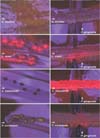Abstract
Objectives
Dental plaque is composed of 700 bacterial species. It is known that some oral microorganisms produce porphyrin, and thus, they emit red fluorescence when illuminated with blue light at a specific wavelength of <410 nm. Porphyromonas gingivalis belongs to the genus Porphyromonas, which is characterized by the production of porphyrin. The aim of this study was to evaluate red fluorescence emission of some oral microorganisms interacting with P. gingivalis.
Methods
Five bacterial strains (P. gingivalis, Streptococcus mutans, Lactobacillus casei, Actinomyces naeslundii, and Fusobacterium nucleatum) were used for this study. Tryptic soy agar medium supplemented with hemin, vitamin K3, and sheep blood was used as a growth medium. The fluorescence emission of bacterial colonies was evaluated under 405 nm-wavelength blue light using a Quantitative Light-induced Fluorescence Digital (QLF-D) camera system. Each bacterium was cultured alone and co-cultured in close proximity with P. gingivalis. The red/green (R/G) ratio of fluorescence image was calculated and the differences of R/G ratio according to each growth condition were compared using the Mann-Whitney test (P<0.05).
Results
Single cultured S. mutans, L. casei and A. naeslundii colonies emitted red fluorescence (R/G ratio=2.15±0.06, 4.31±0.17, 5.52±1.29, respectively). Fusobacterium nucleatum colonies emitted green fluorescence (R/G ratio=1.36±0.06). The R/G ratios of A. naeslundii and F. nucleatum were increased when P. gingivalis was co-cultured with each bacterium (P<0.05). In contrast, the R/G ratios of S. mutans and L. casei were decreased when P. gingivalis was co-cultured with each bacterium (P=0.002, 0.003).
Figures and Tables
References
1. Kim JB, Choi YJ, Paik DI, et al. Preventive dentistry. 4th ed. Seoul: KMS;2004. p. 282–287.
2. Paster BJ, Olsen I, Aas JA, Dewhirst FE. The breadth of bacterial diversity in the human periodontal pocket and other oral sites. Periodontol 2000. 2006; 42:80–87.

3. Kolenbrander PE, Palmer RJ Jr, Periasamy S, Jakubovics NS. Oral multispecies biofilm development and the key role of cell - cell distance. Nat Rev Microbiol. 2010; 8:471–480.

5. Lee ES, Kang SM, Ko HY, Kwon HK, Kim BI. Association between the cariogenicity of a dental microcosm biofilm and its red fluorescence detected by Quantitative Light-induced Fluorescence-Digital (QLF-D). J Dent. 2013; 41:1264–1270.

6. Hibst R, Paulus R. Caries detection by red excited fluorescence: investigations on fluorophores (abstract). Caries Res. 1999; 33:295.
7. Koenig K, Schneckenburger H. Laser-induced autofluorescence for medical diagnosis. J Fluoresc. 1994; 4:17–40.

8. Dolowy WC, Brandes ML, Gouterman M, Parker JD, Lind J. Fluorescence of dental calculus from cats, dogs, and humans and of bacteria cultured from dental calculus. J Vet Dent. 1995; 12:105–109.

9. Fluorescence conjugation [Internet]. Wikipedia;cited 2016 Nov. Available from: https://en.wikipedia.org/wiki/Fluorescence_in_the_life_sciences.
10. Resonance [Internet]. Naver;cited 2017 Jan. Available from: http://terms.naver.com/entry.nhn?docId=2277756&cid=42419&categoryId=42419.
11. Resonance fluorescence [Internet]. Naver;cited 2017 Jan. Available from: http://terms.naver.com/entry.nhn?docId=1063266&ref=y&cid=40942&categoryId=32227.
12. Lennon AM, Buchalla W, Brune L, Zimmermann O, Gross U, Attin T. The ability of selected oral microorganisms to emit red fluorescence. Caries Res. 2006; 40:2–5.

13. Volgenant CM, Van der Veen MH, de Soet JJ, ten Cate JM. Effect of metalloporphyrins on red autofluorescence from oral bacteria. Eur J Oral Sci. 2013; 121:156–161.

14. Coulthwaite L, Pretty IA, Smith PW, Higham SM, Verran J. The microbiological origin of fluorescence observed in plaque on dentures during QLF analysis. Caries Res. 2006; 40:112–116.

15. Van der Veen MH, Thomas RZ, Huysmans MC, de Soet JJ. Red autofluorescence of dental plaque bacteria. Caries Res. 2006; 40:542–545.

16. Fyrestam J, Bjurshammar N, Paulsson E, Mansouri N, Johannsen A, Östman C. Influence of Culture Conditions on Porphyrin Production in Aggregatibacter actinomycetemcomitans and Porphyromonas gingivalis. Photodiagnosis Photodyn Ther. 2017; 17:115–123.

18. Kolenbrander PE, Palmer RJ Jr, Periasamy S, Jakubovics NS. Oral multispecies biofilm development and the key role of cell - cell distance. Nat Rev Microbiol. 2010; 8:471–480.





 PDF
PDF ePub
ePub Citation
Citation Print
Print





 XML Download
XML Download